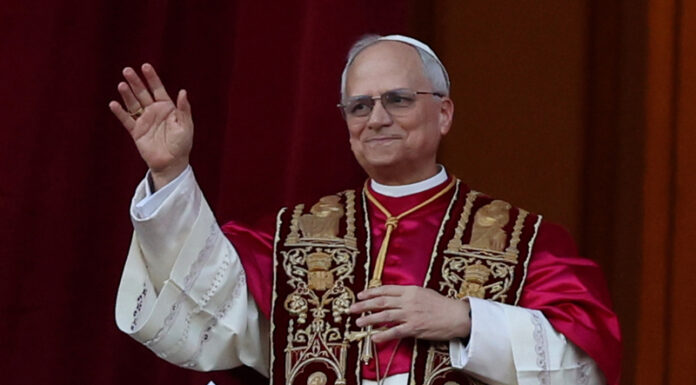Pope Leo XIV resumed activity on the official papal X account on Wednesday, May 14, 2025, swiftly engaging in a series of tweets advocating for peace and denouncing ongoing global conflicts. The American pontiff, elected recently after Pope Francis’s death, quickly established his online presence to communicate his stance on world peace to a global audience.
At around 8 a.m. Eastern Time, Pope Leo XIV sent his first message from the @Pontifex account, starting with a greeting that echoed the words of Jesus Christ. “Peace be with you all!” he wrote. “This is the first greeting spoken by the Risen Christ, the Good Shepherd. I would like this greeting of peace to resound in your hearts, in your families, and among all people, wherever they may be, in every nation and throughout the world.”
Approximately 90 minutes later, the Pope returned to the platform with vigor, posting six additional tweets within 13 minutes, adopting a rapid communication style similar to that of President Donald Trump on his social media platform, Truth Social.
“There is so much violence and so many wars in our world!” Pope Leo XIV wrote in one of his emotional posts. “Amid this horror that should provoke outrage—as people die in the name of military conquest—stands the call of Christ, who repeats: ‘Peace be with you!'”
He contacted global leaders, expressing the Vatican’s willingness to facilitate peace talks. The Pope emphasized the Holy See’s readiness to help adversaries meet face to face, fostering an environment where people can regain the dignity that peace brings. He urged world leaders to engage in dialogue and negotiations, stating, “Let us meet, let us talk, let us work toward peace.”
These online declarations reflect the Pope’s themes since his election on May 8. In his initial public appearances, he has consistently highlighted concerns about specific ongoing conflicts, such as the Russia-Ukraine war, the war in Gaza, and tensions between India and Pakistan.
The pontiff’s social media activity marks a notable change from his previously reserved communication style. As Cardinal Robert Prevost, Leo was known as a quiet, thoughtful, and moderate church leader, contrasting with his predecessor, Pope Francis, who was recognized for his outspoken advocacy and willingness to break with tradition.
During his first Sunday blessing from St. Peter’s Basilica on May 11, Pope Leo XIV reinforced these calls for peace to an estimated crowd of 100,000 faithful gathered below.
The Pope expressed deep concern for Ukraine, highlighting the suffering endured by its people and urging that all efforts be made to secure a genuine, just, and lasting peace as soon as possible. This call for peace came shortly after his reported telephone conversation with Ukrainian President Volodymyr Zelensky on May 12, during which he extended personal support for resolving the ongoing conflict.
Additionally, the Pope voiced concern about Gaza, calling for “an immediate ceasefire” and for “humanitarian aid to be provided to the exhausted civilian population and all hostages be freed.” He welcomed the recent ceasefire between India and Pakistan, hoping negotiations would lead to a lasting accord, while acknowledging “there are so many other conflicts in the world.”
While Leo’s rapid succession of tweets may seem surprising for a pontiff who previously maintained a low profile on social media, Vatican communications officials have confirmed that he intends to maintain an active presence on both X and Instagram. According to a press release from the Vatican’s Dicastery for Communication, the papal social media accounts previously managed by Pope Francis accumulated approximately 50,000 posts and received over 27 billion views in 2020 alone.
Pope Leo XIV’s decision to use the @Pontifex account follows a precedent established by Pope Benedict XVI, who became the first pontiff to join Twitter in December 2012 at the age of 84. The account has grown to more than 52 million followers across nine languages.
What distinguishes Pope Leo XIV’s social media presence from his predecessors is that he was already active on the platform before his elevation to the papacy. His personal account, @drprevost, which he established in August 2011, has resurfaced with increased scrutiny since his election. Some of his previous posts, including criticisms of Vice President J.D. Vance and President Donald Trump’s immigration policies, have sparked controversy among conservative Catholics.
In March 2025, then-Cardinal Prevost shared an article criticizing Vice President Vance for allegedly misrepresenting Catholic teaching to support mass deportation policies. “JD Vance is wrong,” he wrote at the time. Less than a month before becoming pope, he retweeted content challenging the Trump administration’s approach to deporting undocumented migrants without due process.
These past statements have drawn backlash from some conservative circles, with certain right-wing commentators accusing the new pontiff of being “anti-MAGA” and suffering from “Trump Derangement Syndrome.” However, the Pope’s focus appears to have shifted firmly toward promoting dialogue and peace on a global scale since assuming his new role.
Pope Leo XIV has indicated that he chose his papal name in homage to Pope Leo XIII, who reigned from 1878 to 1903 and was known for his pioneering Catholic social teaching during the first industrial revolution. The current Pope appears interested in addressing similar challenges in the modern era, particularly regarding artificial intelligence and human dignity.
Pope Leo XIV further emphasized his commitment to peace-oriented communication during a meeting with journalists on Monday. He stressed the importance of communication, which prioritizes listening and amplifies the voices of the weak and voiceless, rather than relying on loud and forceful expression. He encouraged people to disarm their language for a more peaceful world.
The Pope’s sudden flurry of tweets, combined with his prominent public calls for peace, suggests that promoting dialogue and reconciliation will be central themes of his papacy. Through his strategic use of social media, Pope Leo XIV appears determined to amplify his message of peace to reach beyond traditional Catholic audiences into the broader digital landscape.








